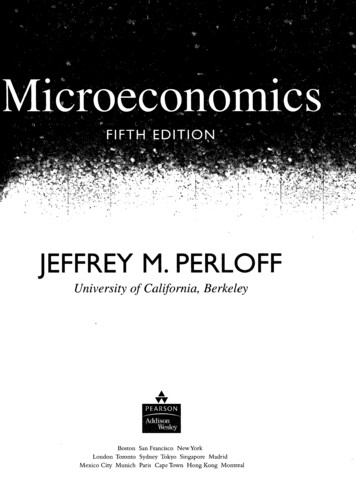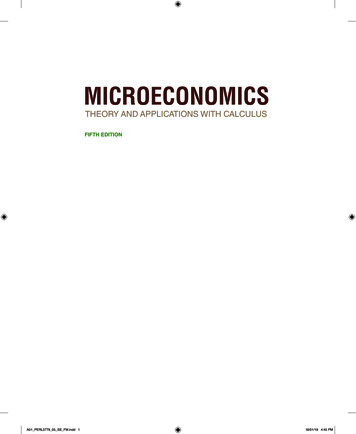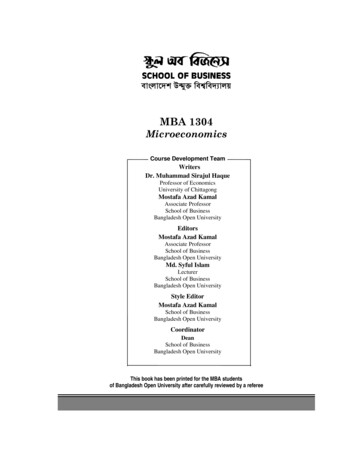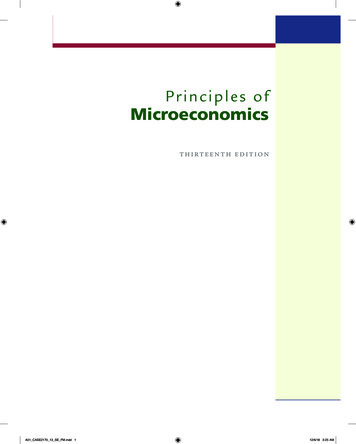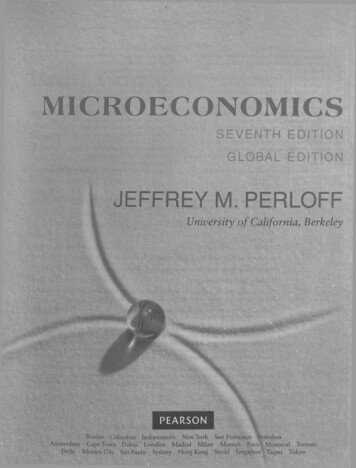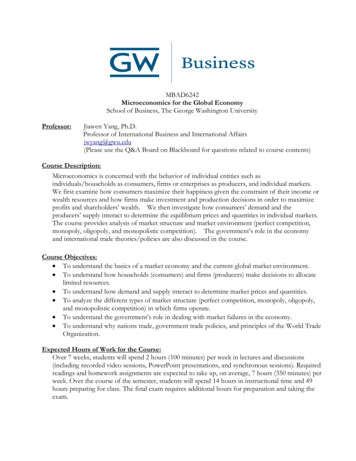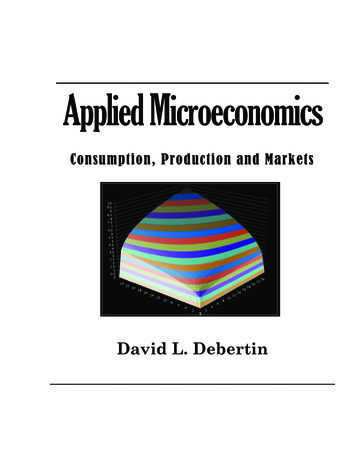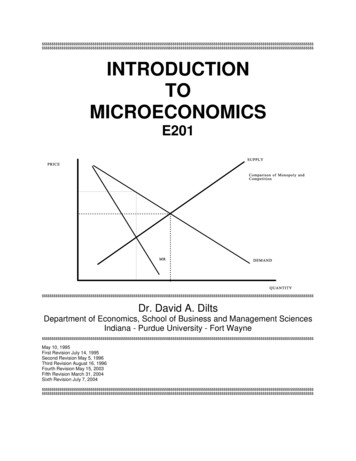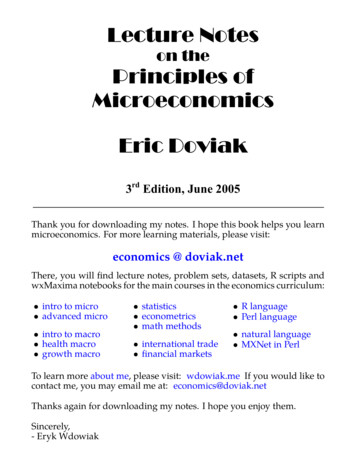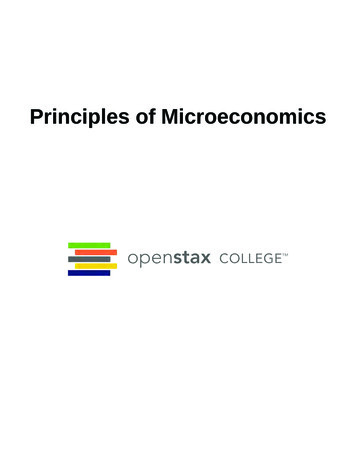
Transcription
Principles of Microeconomics
OpenStax CollegeRice University6100 Main Street MS-380Houston, Texas 77005To learn more about OpenStax College, visit http://openstaxcollege.org.Individual print copies and bulk orders can be purchased through our website. 2014 Rice University. Textbook content produced by OpenStax College is licensed under a Creative Commons Attribution 4.0License. Under this license, any user of this textbook or the textbook contents herein must provide proper attribution as follows:--If you redistribute this textbook in a digital format (including but not limited to EPUB, PDF, and HTML), then you must retain onevery page the following attribution:“Download for free at http://cnx.org/content/col11627/latest.”If you redistribute this textbook in a print format, then you must include on every physical page the following attribution:“Download for free at http://cnx.org/content/col11627/latest.”If you redistribute part of this textbook, then you must retain in every digital format page view (including but not limited toEPUB, PDF, and HTML) and on every physical printed page the following attribution:“Download for free at http://cnx.org/content/col11627/latest.”If you use this textbook as a bibliographic reference, then you should cite it as follows: OpenStax College, Principles ofMicroeconomics. OpenStax College. 19 March 2014. http://cnx.org/content/col11627/latest .The OpenStax College name, OpenStax College logo, OpenStax College book covers, Connexions name, and Connexionslogo are not subject to the license and may not be reproduced without the prior and express written consent of RiceUniversity. For questions regarding this license, please contact partners@openstaxcollege.org.TrademarksThe OpenStax College name, OpenStax College logo, OpenStax College book covers, Connexions name, and Connexions logo areregistered trademarks of Rice University. All rights reserved. Any of the trademarks, service marks, collective marks, design rights, orsimilar rights that are mentioned, used, or cited in OpenStax College, Connexions, or Connexions’ sites are the property of theirrespective visionME-1-001-RS
OpenStax CollegeOpenStax College is a non-profit organization committed to improving student access to quality learning materials. Our free textbooksare developed and peer-reviewed by educators to ensure they are readable, accurate, and meet the scope and sequence requirementsof modern college courses. Through our partnerships with companies and foundations committed to reducing costs for students,OpenStax College is working to improve access to higher education for all.ConnexionsThe technology platform supporting OpenStax College is Connexions (http://cnx.org), one of the world’s first and largest openeducation projects. Connexions provides students with free online and low-cost print editions of the OpenStax College library andprovides instructors with tools to customize the content so that they can have the perfect book for their course.Rice UniversityOpenStax College and Connexions are initiatives of Rice University. As a leading researchuniversity with a distinctive commitment to undergraduate education, Rice University aspiresto path-breaking research, unsurpassed teaching, and contributions to the betterment of ourworld. It seeks to fulfill this mission by cultivating a diverse community of learning anddiscovery that produces leaders across the spectrum of human endeavor.Foundation SupportOpenStax College is grateful for the tremendous support of our sponsors. Without their strong engagement, the goal of free access tohigh-quality textbooks would remain just a dream.Laura and John Arnold Foundation (LJAF) actively seeks opportunities to invest in organizations and thoughtleaders that have a sincere interest in implementing fundamental changes that not only yield immediate gains, butalso repair broken systems for future generations. LJAF currently focuses its strategic investments on education,criminal justice, research integrity, and public accountability.THE CALVIN K.KAZANJIANECONOMICS FOUNDATIONCalvin K. Kazanjian was the founder and president of Peter Paul Inc., the maker of the Mounds and Almond Joycandy bars, located in Naugatuck, Connecticut. He firmly believed that if more people understood basiceconomics the world would be a better place in which to live. Accordingly, he established the Foundation in thetrue spirit of unselfish service. The Calvin K. Kazanjian Economics Foundation Inc. is a non-political educationorganization that was incorporated as a nonprofit organization under the Statue Laws of the State of Connecticuton April 4, 1947.The William and Flora Hewlett Foundation has been making grants since 1967 to help solve social andenvironmental problems at home and around the world. The Foundation concentrates its resources on activities ineducation, the environment, global development and population, performing arts, and philanthropy, and makesgrants to support disadvantaged communities in the San Francisco Bay Area.Guided by the belief that every life has equal value, the Bill & Melinda Gates Foundation works to help all peoplelead healthy, productive lives. In developing countries, it focuses on improving people’s health with vaccines andother life-saving tools and giving them the chance to lift themselves out of hunger and extreme poverty. In theUnited States, it seeks to significantly improve education so that all young people have the opportunity to reachtheir full potential. Based in Seattle, Washington, the foundation is led by CEO Jeff Raikes and Co-chair WilliamH. Gates Sr., under the direction of Bill and Melinda Gates and Warren Buffett.The Maxfield Foundation supports projects with potential for high impact in science, education, sustainability, andother areas of social importance.Our mission at the Twenty Million Minds Foundation is to grow access and success by eliminating unnecessaryhurdles to affordability. We support the creation, sharing, and proliferation of more effective, more affordableeducational content by leveraging disruptive technologies, open educational resources, and new models forcollaboration between for-profit, nonprofit, and public entities.
2This content is available for free at http://cnx.org/content/col11627/1.9
3Table of ContentsPreface . . . . . . . . . . . . . . . . . . . . . . . . . . . . . . . . . . . . . . . . . .Chapter 1: Welcome to Economics! . . . . . . . . . . . . . . . . . . . . . . . . . .1.1 What Economics Is and Why It's Important . . . . . . . . . . . . . . . . . .1.2 Microeconomics and Macroeconomics . . . . . . . . . . . . . . . . . . . .1.3 How Economists Use Theories and Models to Understand Economic Issues .1.4 How Economies Can Be Organized: An Overview of Economic Systems . . .Chapter 2: Choice in a World of Scarcity . . . . . . . . . . . . . . . . . . . . . . .2.1 How Individuals Make Choices Based on Their Budget Constraint . . . . . .2.2 The Production Possibilities Frontier and Social Choices . . . . . . . . . . .2.3 Confronting Objections to the Economic Approach . . . . . . . . . . . . . .Chapter 3: Demand and Supply . . . . . . . . . . . . . . . . . . . . . . . . . . . .3.1 Demand, Supply, and Equilibrium in Markets for Goods and Services . . . .3.2 Shifts in Demand and Supply for Goods and Services . . . . . . . . . . . .3.3 Changes in Equilibrium Price and Quantity: The Four-Step Process . . . . .3.4 Price Ceilings and Price Floors . . . . . . . . . . . . . . . . . . . . . . . .3.5 Demand, Supply, and Efficiency . . . . . . . . . . . . . . . . . . . . . . . .Chapter 4: Labor and Financial Markets . . . . . . . . . . . . . . . . . . . . . . .4.1 Demand and Supply at Work in Labor Markets . . . . . . . . . . . . . . . .4.2 Demand and Supply in Financial Markets . . . . . . . . . . . . . . . . . . .4.3 The Market System as an Efficient Mechanism for Information . . . . . . . .Chapter 5: Elasticity . . . . . . . . . . . . . . . . . . . . . . . . . . . . . . . . . .5.1 Price Elasticity of Demand and Price Elasticity of Supply . . . . . . . . . . .5.2 Polar Cases of Elasticity and Constant Elasticity . . . . . . . . . . . . . . .5.3 Elasticity and Pricing . . . . . . . . . . . . . . . . . . . . . . . . . . . . . .5.4 Elasticity in Areas Other Than Price . . . . . . . . . . . . . . . . . . . . . .Chapter 6: Consumer Choices . . . . . . . . . . . . . . . . . . . . . . . . . . . . .6.1 Consumption Choices . . . . . . . . . . . . . . . . . . . . . . . . . . . . .6.2 How Changes in Income and Prices Affect Consumption Choices . . . . . .6.3 Labor-Leisure Choices . . . . . . . . . . . . . . . . . . . . . . . . . . . . .6.4 Intertemporal Choices in Financial Capital Markets . . . . . . . . . . . . . .Chapter 7: Cost and Industry Structure . . . . . . . . . . . . . . . . . . . . . . . .7.1 Explicit and Implicit Costs, and Accounting and Economic Profit . . . . . . .7.2 The Structure of Costs in the Short Run . . . . . . . . . . . . . . . . . . . .7.3 The Structure of Costs in the Long Run . . . . . . . . . . . . . . . . . . . .Chapter 8: Perfect Competition . . . . . . . . . . . . . . . . . . . . . . . . . . . .8.1 Perfect Competition and Why It Matters . . . . . . . . . . . . . . . . . . . .8.2 How Perfectly Competitive Firms Make Output Decisions . . . . . . . . . . .8.3 Entry and Exit Decisions in the Long Run . . . . . . . . . . . . . . . . . . .8.4 Efficiency in Perfectly Competitive Markets . . . . . . . . . . . . . . . . . .Chapter 9: Monopoly . . . . . . . . . . . . . . . . . . . . . . . . . . . . . . . . . .9.1 How Monopolies Form: Barriers to Entry . . . . . . . . . . . . . . . . . . .9.2 How a Profit-Maximizing Monopoly Chooses Output and Price . . . . . . . .Chapter 10: Monopolistic Competition and Oligopoly . . . . . . . . . . . . . . . .10.1 Monopolistic Competition . . . . . . . . . . . . . . . . . . . . . . . . . . .10.2 Oligopoly . . . . . . . . . . . . . . . . . . . . . . . . . . . . . . . . . . .Chapter 11: Monopoly and Antitrust Policy . . . . . . . . . . . . . . . . . . . . . .11.1 Corporate Mergers . . . . . . . . . . . . . . . . . . . . . . . . . . . . . .11.2 Regulating Anticompetitive Behavior . . . . . . . . . . . . . . . . . . . . .11.3 Regulating Natural Monopolies . . . . . . . . . . . . . . . . . . . . . . . .11.4 The Great Deregulation Experiment . . . . . . . . . . . . . . . . . . . . .Chapter 12: Environmental Protection and Negative Externalities . . . . . . . . .12.1 The Economics of Pollution . . . . . . . . . . . . . . . . . . . . . . . . . .12.2 Command-and-Control Regulation . . . . . . . . . . . . . . . . . . . . . .12.3 Market-Oriented Environmental Tools . . . . . . . . . . . . . . . . . . . .12.4 The Benefits and Costs of U.S. Environmental Laws . . . . . . . . . . . . .12.5 International Environmental Issues . . . . . . . . . . . . . . . . . . . . . .12.6 The Tradeoff between Economic Output and Environmental Protection . . .Chapter 13: Positive Externalitites and Public Goods . . . . . . . . . . . . . . . .13.1 Why the Private Sector Under Invests in Innovation . . . . . . . . . . . . .13.2 How Governments Can Encourage Innovation . . . . . . . . . . . . . . . .13.3 Public Goods . . . . . . . . . . . . . . . . . . . . . . . . . . . . . . . . . 3264268271
4Chapter 14: Poverty and Economic Inequality . . . . . . . . . . . . . . . . . . . .14.1 Drawing the Poverty Line . . . . . . . . . . . . . . . . . . . . . . . . . . .14.2 The Poverty Trap . . . . . . . . . . . . . . . . . . . . . . . . . . . . . . .14.3 The Safety Net . . . . . . . . . . . . . . . . . . . . . . . . . . . . . . . .14.4 Income Inequality: Measurement and Causes . . . . . . . . . . . . . . . .14.5 Government Policies to Reduce Income Inequality . . . . . . . . . . . . . .Chapter 15: Issues in Labor Markets: Unions, Discrimination, Immigration . . . .15.1 Unions . . . . . . . . . . . . . . . . . . . . . . . . . . . . . . . . . . . .15.2 Employment Discrimination . . . . . . . . . . . . . . . . . . . . . . . . . .15.3 Immigration . . . . . . . . . . . . . . . . . . . . . . . . . . . . . . . . . .Chapter 16: Information, Risk, and Insurance . . . . . . . . . . . . . . . . . . . .16.1 The Problem of Imperfect Information and Asymmetric Information . . . . .16.2 Insurance and Imperfect Information . . . . . . . . . . . . . . . . . . . . .Chapter 17: Financial Markets . . . . . . . . . . . . . . . . . . . . . . . . . . . . .17.1 How Businesses Raise Financial Capital . . . . . . . . . . . . . . . . . . .17.2 How Households Supply Financial Capital . . . . . . . . . . . . . . . . . .17.3 How to Accumulate Personal Wealth . . . . . . . . . . . . . . . . . . . . .Chapter 18: Public Economy . . . . . . . . . . . . . . . . . . . . . . . . . . . . . .18.1 Voter Participation and Costs of Elections . . . . . . . . . . . . . . . . . .18.2 Special Interest Politics . . . . . . . . . . . . . . . . . . . . . . . . . . . .18.3 Flaws in the Democratic System of Government . . . . . . . . . . . . . . .Chapter 19: International Trade . . . . . . . . . . . . . . . . . . . . . . . . . . . .19.1 Absolute and Comparative Advantage . . . . . . . . . . . . . . . . . . . .19.2 What Happens When a Country Has an Absolute Advantage in All Goods .19.3 Intra-industry Trade between Similar Economies . . . . . . . . . . . . . . .19.4 The Benefits of Reducing Barriers to International Trade . . . . . . . . . .Chapter 20: Globalization and Protectionism . . . . . . . . . . . . . . . . . . . . .20.1 Protectionism: An Indirect Subsidy from Consumers to Producers . . . . . .20.2 International Trade and Its Effects on Jobs, Wages, and Working Conditions20.3 Arguments in Support of Restricting Imports . . . . . . . . . . . . . . . . .20.4 How Trade Policy Is Enacted: Globally, Regionally, and Nationally . . . . .20.5 The Tradeoffs of Trade Policy . . . . . . . . . . . . . . . . . . . . . . . .A The Use of Mathematics in Principles of Economics . . . . . . . . . . . . . . .B Indifference Curves . . . . . . . . . . . . . . . . . . . . . . . . . . . . . . . . . .C Present Discounted Value . . . . . . . . . . . . . . . . . . . . . . . . . . . . . .Index . . . . . . . . . . . . . . . . . . . . . . . . . . . . . . . . . . . . . . . . . . .This content is available for free at 77378383387390397398404407412415423439451486
5PREFACEWelcome to Principles of Microeconomics, an OpenStax College resource. This textbook has been created with severalgoals in mind: accessibility, customization, and student engagement—all while encouraging students toward high levelsof academic scholarship. Instructors and students alike will find that this textbook offers a strong foundation inmicroeconomics in an accessible format.About OpenStax CollegeOpenStax College is a non-profit organization committed to improving student access to quality learning materials. Ourfree textbooks go through a rigorous editorial publishing process. Our texts are developed and peer-reviewed by educatorsto ensure they are readable, accurate, and meet the scope and sequence requirements of today’s college courses. Unliketraditional textbooks, OpenStax College resources live online and are owned by the community of educators using them.Through our partnerships with companies and foundations committed to reducing costs for students, OpenStax College isworking to improve access to higher education for all. OpenStax College is an initiative of Rice University and is madepossible through the generous support of several philanthropic foundations.About OpenStax College’s ResourcesOpenStax College resources provide quality academic instruction. Three key features set our materials apart from others:they can be customized by instructors for each class, they are a "living" resource that grows online through contributionsfrom science educators, and they are available free or for minimal cost.CustomizationOpenStax College learning resources are designed to be customized for each course. Our textbooks provide a solidfoundation on which instructors can build, and our resources are conceived and written with flexibility in mind. Instructorscan select the sections most relevant to their curricula and create a textbook that speaks directly to the needs of their classesand student body. Teachers are encouraged to expand on existing examples by adding unique context via geographicallylocalized applications and topical connections.Principles of Microeconomics can be easily customized using our online platform (http://cnx.org/content/col11627/).Simply select the content most relevant to your current semester and create a textbook that speaks directly to the needsof your class. Principles of Microeconomics is organized as a collection of sections that can be rearranged, modified, andenhanced through localized examples or to incorporate a specific theme of your course. This customization feature willensure that your textbook truly reflects the goals of your course.CurationTo broaden access and encourage community curation, Principles of Microeconomics is “open source” licensed undera Creative Commons Attribution (CC-BY) license. The economics community is invited to submit examples, emergingresearch, and other feedback to enhance and strengthen the material and keep it current and relevant for today’s students.Submit your suggestions to info@openstaxcollege.org, and check in on edition status, alternate versions, errata, and newson the StaxDash at http://openstaxcollege.org.CostOur textbooks are available for free online, and in low-cost print and e-book editions.About Principles of MicroeconomicsPrinciples of Microeconomics has been developed to meet the scope and sequence of most introductory microeconomicscourses. At the same time, the book includes a number of innovative features designed to enhance student learning.Instructors can also customize the book, adapting it to the approach that works best in their classroom.Coverage and ScopeTo develop Principles of Microeconomics, we acquired the rights to Timothy Taylor’s second edition of Principles ofEconomics and solicited ideas from economics instructors at all levels of higher education, from community colleges toPh.D.-granting universities. They told us about their courses, students, challenges, resources, and how a textbook can bestmeet the needs of both instructors and students.The result is a book that covers the breadth of economics topics and also provides the necessary depth to ensure the course ismanageable for instructors and students alike. And to make it more applied, we have incorporated many current topics. Wehope students will be interested to know just how far-reaching the recent recession was (and still is), for example, and why
6there is so much controversy even among economists over the Affordable Care Act (Obamacare). The Keystone Pipeline,Occupy Wall Street, and minimum wage debates are just a few of the other important topics covered.The pedagogical choices, chapter arrangements, and learning objective fulfillment were developed and vetted with feedbackfrom educators dedicated to the project. They thoroughly read the material and offered critical and detailed commentary.The outcome is a balanced approach to microeconomics, particularly to the theory and application of economics concepts.Current events are treated in a politically-balanced way as well.The book is organized into five main parts:What is Economics? The first two chapters introduce students to the study of economics with a focus on makingchoices in a world of scarce resources.Supply and Demand, Chapters 3 and 4, introduces and explains the first analytical model in economics: supply,demand, and equilibrium, before showing applications in the markets for labor and finance.The Fundamentals of Microeconomic Theory, Chapters 5 through 10, begins the microeconomics portion of thetext, presenting the theories of consumer behavior, production and costs, and the different models of market structure,including some simple game theory.Microeconomic Policy Issues, Chapters 11 through 18, covers the range of topics in applied micro, framed around theconcepts of public goods and positive and negative externalities. Students explore competition and antitrust policies,environmental problems, poverty, income inequality, and other labor market issues. The text also covers information,risk and financial markets, as well as public economy.International Economics, Chapters 19 and 20, the final part of the text, introduces the international dimensions ofeconomics, including international trade and protectionism.Chapter 1 Welcome to Economics!Chapter 2 Choice in a World of ScarcityChapter 3 Demand and SupplyChapter 4 Labor and Financial MarketsChapter 5 ElasticityChapter 6 Consumer ChoicesChapter 7 Cost and Industry StructureChapter 8 Perfect CompetitionChapter 9 MonopolyChapter 10 Monopolistic Competition and OligopolyChapter 11 Monopoly and Antitrust PolicyChapter 12 Environmental Protection and Negative ExternalitiesChapter 13 Positive Externalities and Public GoodsChapter 14 Poverty and Economic InequalityChapter 15 Issues in Labor Markets: Unions, Discrimination, ImmigrationChapter 16 Information, Risk, and InsuranceChapter 17 Financial MarketsChapter 18 Public EconomyChapter 19 International TradeChapter 20 Globalization and ProtectionismAppendix A The Use of Mathematics in Principles of EconomicsAppendix B Indifference CurvesAppendix C Present Discounted ValueAlternate SequencingPrinciples of Economics was conceived and written to fit a particular topical sequence, but it can be used flexibly toaccommodate other course structures. One such potential structure, which will fit reasonably well with the textbook content,is provided. Please consider, however, that the chapters were not written to be completely independent, and that theproposed alternate sequence should be carefully considered for student preparation and textual consistency.Chapter 1 Welcome to Economics!Chapter 2 Choice in a World of ScarcityChapter 3 Demand and SupplyChapter 4 Labor and Financial MarketsChapter 5 ElasticityChapter 6 Consumer ChoicesChapter 19 International TradeChapter 7 Cost and Industry StructureChapter 12 Environmental Protection and Negative ExternalitiesThis content is available for free at http://cnx.org/content/col11627/1.9
7Chapter 13 Positive Externalities and Public GoodsChapter 8 Perfect CompetitionChapter 9 MonopolyChapter 10 Monopolistic Competition and OligopolyChapter 11 Monopoly and Antitrust PolicyChapter 14 Poverty and Economic InequalityChapter 15 Issues in Labor Markets: Unions, Discrimination, ImmigrationChapter 16 Information, Risk, and InsuranceChapter 17 Financial MarketsChapter 18 Public EconomyChapter 20 Globalization and ProtectionismAppendix A The Use of Mathematics in Principles of EconomicsAppendix B Indifference CurvesAppendix C Present Discounted ValuePedagogical FoundationThroughout the OpenStax version of Principles of Microeconomics, you will find new features that engage the students ineconomic inquiry by taking selected topics a step further. Our features include:Bring It Home: This added feature is a brief case study, specific to each chapter, which connects the chapter’s maintopic to the real word. It is broken up into two parts: the first at the beginning of the chapter (in the Intro module) andthe second at chapter’s end, when students have learned what’s necessary to understand the case and “bring home” thechapter’s core concepts.Work It Out: This added feature asks students to work through a generally analytical or computational problem, andguides them step-by-step to find out how its solution is derived.Clear It Up: This boxed feature, which includes pre-existing features from Taylor’s text, addresses common studentmisconceptions about the content. Clear It Ups are usually deeper explanations of something in the main body of thetext. Each CIU starts with a question. The rest of the feature explains the answer.Link It Up: This added feature is a very brief introduction to a website that is pertinent to students’ understanding andenjoyment of the topic at hand.Questions for Each Level of LearningThe OpenStax version of Principles of Microeconomics further expands on Taylor’s original end of chapter materials byoffering four types of end-of-module questions for students.Self-Checks: Are analytical self-assessment questions that appear at the end of each module. They “click–to-reveal”an answer in the web view so students can check their understanding before moving on to the next module. SelfCheck questions are not simple look-up questions. They push the student to think a bit beyond what is said in the text.Self-Check questions are designed for formative (rather than summative) assessment. The questions and answers areexplained so that students feel like they are being walked through the problem.Review Questions: Have been retained from Taylor’s version, and are simple recall questions from the chapter andare in open-response format (not multiple choice or true/false). The answers can be looked up in the text.Critical Thinking Questions: Are new higher-level, conceptual questions that ask students to demonstrate theirunderstanding by applying what they have learned in different contexts. They ask for outside-the-box thinking, forreasoning about the concepts. They push the student to places they wouldn’t have thought of going themselves.Problems: Are exercises that give students additional practice working with the analytic and computational conceptsin the module.Updated ArtPrinciples of Microeconomics includes an updated art program to better inform today’s student, providing the latest data oncovered topics.
8Since 2000, corporate profits after tax have mostly continued to increase each year, save for a substantialdecrease between 2008 and 2009 as a result of the Great Recession. (Source: http://research.stlouisfed.org/fred2)About Our TeamSenior Contributing AuthorTimothy Taylor, Macalester CollegeTimothy Taylor has been writing and teaching about economics for 30 years, and is the Managing Editor of the Journalof Economic Perspectives, a post he’s held since 1986. He has been a lecturer for The Teaching Company, the Universityof Minnesota, and the Hubert H. Humphrey Institute of Public Affairs, where students voted him Teacher of the Year in1997. His writings include numerous pieces for journals such as the Milken Institute Review and The Public Interest, andhe has been an editor on many projects, most notably for the Brookings Institution and the World Bank, where he wasChief Outside Editor for the World Development Report 1999/2000, Entering the 21st Century: The Changing DevelopmentLandscape. He also blogs four to five times per week at http://conversableeconomist.blogspot.com. Timothy Taylor livesnear Minneapolis with his wife Kimberley and their three children.Senior Content ExpertSteven A. Greenlaw, University of Mary WashingtonSteven Greenlaw has been teaching principles of economics for more than 30 years. In 1999, he received the Grellet C.Simpson Award for Excellence in Undergraduate Teaching at the University of Mary Washington. He is the author ofDoing Economics: A Guide to Doing and Understanding Economic Research, as well as a variety of articles on economicspedagogy and instructional technology, published in the Journal of Economic Education, the International Review ofEconomic Education, and other outlets. He wrote the module on Quantitative Writing for Starting Point: Teaching andLearning Economics, the web portal on best practices in teaching economics. Steven Greenlaw lives in Alexandria, Virginiawith his wife Kathy and their three children.Senior ContributorsEric DodgeHanover CollegeCynthia GamezUniversity of Texas at El PasoAndres JaureguiColumbus State UniversityDiane KeenanCerritos CollegeDan MacDonaldCalifornia State University San BernardinoAmyaz MoledinaThe College of WoosterThis content is available for free at http://cnx.org/content/col11627/1.9
9Craig RichardsonWinston-Salem State UniversityDavid ShapiroPennsylvania State UniversityRalph SonenshineAmerican UniversityReviewersBryan AguiarNorthwest Arkansas Community CollegeBasil Al HashimiMesa Community CollegeEmil BerendtMount St. Mary's UniversityZena BuserAdams State UniversityDouglas CampbellThe University of MemphisSanjukta ChaudhuriUniversity of Wisconsin - Eau ClaireXueyu ChengAlabama State UniversityRobert CunninghamAlma CollegeRosa Lea DanielsonCollege of DuPageSteven DeloachElon UniversityDebbie EvercloudUniversity of Colorado DenverSal FiguerasHudson County Community CollegeReza GhorashiRichard Stockton College of New JerseyRobert GilletteUniversity of KentuckyGeorge JonesUniversity of Wisconsin-Rock CountyCharles KronckeCollege of Mount St. JosephTeresa LaughlinPalomar Community CollegeCarlos Liard-Murient
The OpenStax College name, OpenStax College logo, OpenStax College book covers, Connexions name, and Connexions logo are not subject to the license and may not be reprodu

